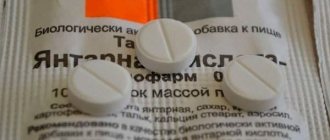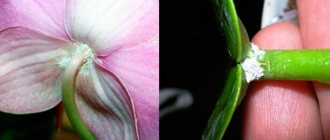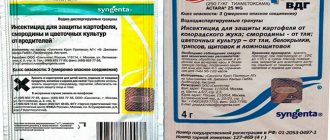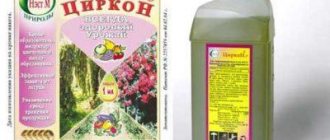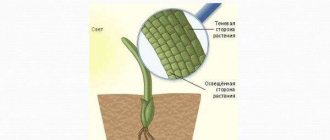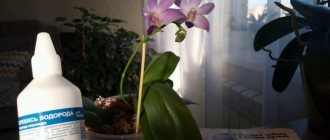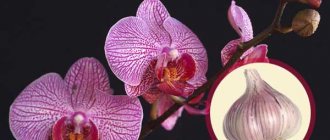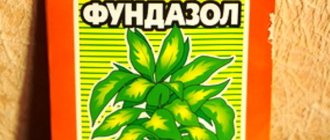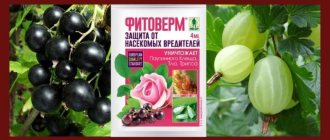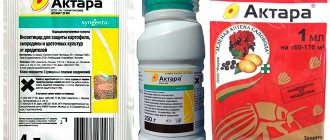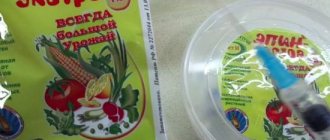Plants » Flowers
0
1839
Article rating
Kira Stoletova
Actara for orchids is an indispensable tool in pest control. A broad-spectrum drug is used for many varieties of indoor plants.
Application of Actara for orchids
Description and active ingredient of the drug "Aktara"
"Aktara" is a chemical insecticide developed in Swiss laboratories. The drug is available in the form of granules that do not dissolve, and when diluted with water they form a homogeneous suspension. This form of release is called “water-dispersible granules” and is designated on the packaging by the abbreviation “VDG”.
The basis of the drug is a chemical compound from the class of neonicotinoids - thiamethoxam. This is a strong nerve poison that can destroy insects on a plant in a few hours, working according to the following mechanism:
- the substance penetrates the orchid tissue and is distributed in the cell sap;
- the insect, feeding on the juices of the plant, eats the poison;
- within a few hours the insect is paralyzed and dies.
“Aktara” applied to the upper side of the orchid leaf blades, thanks to the translaminar effect, is distributed throughout the leaf tissues and protects the lower side. If the drug was applied at the root of the orchid, within 1-3 days it will be distributed throughout all organs of the plant.
Important! A number of studies have shown that thiamethoxam, once in plant tissue, soon forms a metabolite, clothianidin. This is another neonicotinoid that has high resistance and speed of action on pests. Thanks to such chemical transformations, Aktara retains its protective effect for 2 months after treatment.
When processing orchids by leaves, Aktara exhibits translaminar properties. When applied by irrigation - systemic.
Infectious diseases of orchids
It is very interesting to listen to experts and flower growers about the proper care of orchids. And how to deal with various diseases of these plants. But how do orchids cope with such a horde of diseases in their real habitats? Or are there fewer of them? After all, the conditions are natural.
We ourselves are to a greater extent the culprits of their diseases . Either overfilled or underfilled. It's hot, it's cold.
The main cause of disease is improper care.
The main causes of fungal diseases of orchids:
- Root damage. Like during transplants. So and by various pests;
- Excessive watering and stagnation of moisture;
- Poor room ventilation;
- Oversaturation with nitrogen fertilizers;
- Poor quality substrate. Especially its salinity;
- Unacceptable drop in ground temperature;
- Lack of microelements that provide protective functions of plants.
This is interesting: How to properly replant a violet at home, replanting flowering Saintpaulias All parts of the plant can be affected by infections. Regular inspection of plants allows you to quickly detect that not everything is in order with the plant.
Leaves can signal this:
- Darkening;
- Drying and stains;
- Lumps and swellings.
Careful inspection of transparent containers will help determine the condition of the root system. Most often, at home you have to deal with infectious diseases of orchids, which we will discuss below.
Gray rot
Gray rot most often appears on mature plants in the form of brown spots on flowers . Stagnation of cool and humid air most contributes to the development of fungi of this disease. In autumn or spring.
Infection occurs quite quickly: 12-15 hours is enough for nearby other plants to become ill.
Gray rot.
Black rot
The appearance of this disease in orchids is greatly facilitated by pests (bugs, aphids, scale insects). And high humidity and oversaturation of nitrogen in the soil only help its spread.
Black rot.
Anthracnose
Clear small brown spots of a round shape on the leaves ... They indicate that the plant has anthracnose disease:
- Subsequently, the leaves become covered with a black coating or mold with a pinkish tint;
- The affected area is rapidly expanding. If you delay treatment, they can connect and form dents;
- High humidity and stagnant moisture in the leaf axils and cores of pseudobulbs can cause the disease;
- Miltonia, Oncidium, Paphiopedilum, and Phalaenopsis are most often affected.
Thrips
Adult insects have an oblong body 2.5 mm long and live on the soil surface. Thrips on orchids look like tiny black sticks with small wings. Females lay eggs on leaf blades.
You can recognize an orchid infestation with thrips by yellow spots with dots on the leaves and brown necrotic areas on the shoots. The larvae feed on plant sap, which they suck from leaves, buds, and flowers. To examine insects at this stage of development, you need to use a magnifying glass.
Pests enter a room with infected orchids or other plants, or bouquets of flowers. It is necessary to quarantine for two weeks for each new pet in the green corner.
Thrips on an orchid
The fight against the spread of thrips involves improving the light regime and using insecticides. Effective drugs - Aktara, Insektor. A solution of systemic pesticides can not only be sprayed, but also watered on the substrate. The active substance penetrates through the roots into all organs of the plant.
Among biological products for treatment against thrips, it is recommended to give preference to Vertimek and Fitoverm. Spray orchid leaves on both sides, shoots, and aerial roots with an insecticide of biological origin. The disadvantage of biological products is the need for 2 or 3 treatments over 7–10 days.
Folk remedies have low effectiveness against thrips. Often, the use of decoctions and infusions of herbs takes time, but does not lead to the desired result. In case of severe damage, the sequential use of two different insecticides is required: first chemical, and after a week biological.
Shchitovka
The shield aphid is a dangerous pest of orchids. A sign of infestation by this insect is the appearance of small brown scales or waxy tubercles and sticky secretions on the leaves and stems. It is difficult to remove an adult pest - it literally digs into plant tissue.
Shield aphid
The insect's body length is from 1.5 to 4 mm. Wings develop only in males, but the oral apparatus is reduced. Large females do not have legs or wings. The wax-like shield protects well from the penetration of chemicals through the integument into the body.
Scale insects and false scale insects are combined into one superfamily of coccids or scale insects - sucking insects that are dangerous to many plants. Pests of orchids - 4–5 types of scale insects, soft false scale insects. Controlling this group of insects is extremely difficult.
Before getting rid of scale insects on an orchid, you need to isolate the affected specimen from healthy plants. Then you should remove all the brown tubercles. It is recommended to change the substrate, disinfect the pot and treat the orchid with Actellik. Next, a second and third treatment will be required at intervals of 5–6 days.
Whiteflies
Small white midges in orchids spread quickly and infect almost all plants in the collection. Whiteflies are small insects with folded wings. The top of the body seems to be covered with a layer of white powder.
Whitefly
Infestation by these insects causes leaves to turn yellow and fall off. Under the influence of a pest, the plant becomes more susceptible to fungal, viral and bacterial infections.
They begin the fight against whiteflies by replacing the substrate in pots and removing affected leaves. Plants are treated with Aktara, Fitoverm or Aktellik. The soil is watered with a weaker solution of one of the drugs. Fitoverm is effective only with repeated treatments or in combination with other insecticides.
Aphids on an orchid
Small insects suck sap from different parts of plants, transmit viral diseases, and create a favorable environment for the proliferation of sooty fungus. An aphid attack on an orchid is recognized by sticky spots, deformed leaves, fallen unopened buds and dried flowers. Pests form colonies under leaves, on flowers and on the tops of young shoots.
Aphids on an orchid
Aphids are sedentary insects 1–5 mm long. The body is oval in shape, colored in shades of green, pink, brown or black. There are wingless and winged aphids that lay eggs and are viviparous. Females are very fertile - producing more than 100,000 young in one month.
How to get rid of aphids on an orchid:
- Immediately wash the infected plant with a stream of water;
- wrap your fingers in a bandage and remove insects from the affected organs;
- in case of significant infestation, treat with a suitable insecticidal preparation - Fitoverm, Iskra or Aktara;
- repeat spraying after a week, use a different pesticide.
Nettle infusion is a folk remedy for aphids on orchids. Prepare from two handfuls of fresh leaves and 2 liters of cold water. Leave for 12 hours, filter, pour the solution into a spray bottle and treat the plants. The folk remedy works within a week.
You can replace nettle with celandine grass, marigolds, dried tangerine or orange peel, and dry tobacco leaves. It is recommended not only to spray the infected orchids with the prepared infusion, but also to “walk” along the lower surface of the leaves with a soft brush. After 15 minutes, the treated areas are washed with clean water.
This is interesting: Everything about the Uzambara violet: propagation and care of Saintpaulias at home
Spider and armored mites
The diameter of the oval body of the pest is less than 1 mm. The integument of spider mites is usually light green, orange or red-brown in color. Adults and larvae have a piercing-sucking type of mouthparts. Limbs - 4 pairs (aphids and other insects have 6 legs).
Spider mite
You can recognize spider mites on an orchid by the appearance of dots and pale yellow spots on the leaves. Pests weave webs around young shoots and buds. When mites multiply en masse, the leaves dry out and the entire orchid dies. Some species carry pathogens of infectious plant diseases.
The red spider mite is the most dangerous for orchids. Females are very fertile and lay eggs in a warm room all year round. It is useful to use a cold shower against spider mites. You can water the flower generously, cover with a transparent waterproof bag to increase humidity (remove after 3 days).
Pests are destroyed by spraying with Actellik. Rinse the pot with the drug solution and water the soil. There are other acaricides that are relatively safe for people: Fitoverm, Aktofit, Vertimek.
Decoctions of tobacco leaves and Dalmatian chamomile are destructive for ticks. The plants must be dried, finely chopped and left for 12 hours in cold water. The effect of folk remedies is short, so they are used mainly for prevention.
Orchid miteThe orchid mite looks like a tiny shiny ball on the protruding roots and lower part of the shoots. These arachnids feed on dying parts of plants. A large colony of oribatid mites switches to feeding on young leaves of phalaenopsis and dendrobium.
The method of controlling soil pests is to transplant plants into a healthy substrate. Before the procedure, it is necessary to clean the roots from mites. Use Aktellik or Fitoverm for soil etching. Another simple method is to periodically dry the substrate.
Powdery mildew
It is characterized by a covering of leaves and buds with a white coating . It’s as if flour was sprinkled on top:
- If measures are not taken, the plant may die;
- Greenhouse conditions (high humidity and high temperature) can most often cause the development of this disease;
- Affects most domestic orchids.
Fusarium
A dangerous disease of orchids with fungi of the genus Fusarium. There are root and stem forms :
- More often, infection can spread from newly acquired plants or seeds;
- It all starts with redness of the roots;
- Then impressions appear. The roots darken and begin to rot.
Fusarium.
Very important! The effectiveness of treatment depends on early detection and timely measures taken. And the correct use of treatments. A diseased plant must be immediately removed from other flowers.
List of orchid pests sensitive to Aktara
"Aktara" is famous for having a fairly wide spectrum of action. The official regulations provide for the use of this drug on potted indoor plants to protect against the following insects:
- soil flies;
- thrips;
- whiteflies;
- aphids;
- fungus gnats;
- scale insects;
- false scale insects.
In fact, the spectrum of action of this drug is wider. In particular, many gardeners effectively use Aktara to combat the most insidious pest of orchids - the mealybug.
Tip #1. The drug "Aktara" is effective only against insects. If the orchid is affected by spider mites, it is useless to use insecticides. To combat ticks, agents from the class of acaricides or insectoacaricides are needed.
Description
The insecticide "Aktara" is a systemic drug that combines both intestinal and contact action. The product is produced in the form of granules, packaged in 4 g in foil vacuum bags.
Thanks to its systemic action, Aktara is used for indoor plants to combat the following pests: scale insects, aphids, mealybugs, thrips, whiteflies and other insects. The only enemy that the drug cannot cope with is the tick.
Properties of the insecticide "Aktara":
- instant penetration into the shoots, leaves and roots of the plant;
- good solubility and odorlessness;
- efficiency both when spraying and when applied to the soil;
- long-term protection of the plant from several pests at the same time;
- low application rates and small number of treatments;
- long duration of residual action;
- activity at high temperatures, dry air and high humidity;
- resistance to bright sun.
The active ingredient "Aktar" thiamethoxam spreads throughout the plant after 20 hours. When treating a large plant, the drug reaches its top within 3 days.
The effect of Aktara on insects appears within 30-60 minutes. Their digestive system becomes paralyzed and they stop eating. Weak individuals die immediately, and complete destruction of insects occurs within 24 hours.
The time of residual protective effect of the drug when sprayed is 15 - 28 days, when applied to the soil - approximately 40 - 60 days.
An important point is that with repeated treatments, the drug can cause insects to become addicted to it. Therefore, it is recommended to alternate Aktara with other chemicals.
The drug is compatible with all fungicides and other insecticides, except for products that contain soap, lime and Bordeaux mixture.
Dilution and use of Aktary working fluid
Water-dispersible granules must be diluted with water before use. The drug "Aktara" is very strong, the concentration of the active substance in it is high, so dilution is done in a large amount of water:
| Pest | Preparation of working solution | Mode of application |
| Aphids, thrips, whiteflies | 1 g of granules is diluted in 10 liters of water to obtain a homogeneous suspension | Spraying the solution on leaves, pseudobulbs, trunks, peduncles, the top layer of the substrate and aerial roots |
| Fungus gnats and soil flies | 1 g of granules is diluted in 10 liters of water | Pouring the pot with 1 cup of working liquid over a pre-moistened substrate |
| Scale insects, false scale insects, mealybugs | 8 g of granules are diluted in 10 liters of water | Spraying the solution on leaves, pseudobulbs, trunks, peduncles, the top layer of the substrate and aerial roots |
Such a strong dilution of the Aktara preparation makes it not very convenient for use in indoor floriculture, because 10 liters of working suspension is enough to treat 250-300 pots of orchids. The prepared liquid cannot be stored, so the florist is faced with either the problem of disposal or the question of preparing a smaller volume of suspension.
Disposing of chemical pesticide residues into sewers or septic tanks is prohibited. In order not to violate this prohibition, it is useful for orchid lovers to have laboratory scales on their farm. With their help, you can accurately measure ultra-small amounts of drugs and prepare strictly the required amount of working solutions:
- 0.1 g of granules per 1 liter of water – for treating 6-8 orchids against aphids, thrips, whiteflies;
- 0.1 g of granules per 1 liter of water – to treat 4-5 orchids against fungus gnats and soil flies;
- 0.8 g of granules per 1 liter of water – for treating 6-8 orchids against scale insects, false scale insects and mealybugs.
If there are even fewer orchids in the collection, you need to measure out a smaller amount of the Aktara preparation.
If it is not the green organs that are affected by pests, but the orchid flowers, it is advisable to combine two methods of using Aktara - spraying and watering. You need to spray only on the green parts, without touching the flowers and buds. The active substance will reach them through the roots through the conduction system.
Instructions for use
Aktara is designed to destroy harmful insects and is used as soon as traces of their presence are noticed. It can also be used to prevent invasion.
On average, treatment is carried out 2-3 times, with an interval of 7-10 days. Protection against the invasion of voracious insects is ensured if the plant is soaked in Aktara solution before planting in another pot.
Dosage and processing methods
The pesticide can be applied in 3 ways at the following dosage:
- spraying: 1-2 g of powder per 2.5 liters of water, 1-2 ampoules per 1.5 liters of water;
- soil irrigation by watering at the root or by immersion method: 0.25-0.5 g per 2.5 l of water, 5-6 l ampoule;
- 4 g/5 l – for soaking the root system.
The dosage is selected depending on the type and number of pests and the size of the plant.
Orchids of various types.
It’s not scary if the concentration of the solution is higher than normal. This will not harm the plant.
Watering and spraying are combined if the invasion is large-scale. Advantages of root treatment:
- prolonged action (2 months versus 30 days when spraying);
- rapid entry of thiamethoxam into all parts of the plant;
- economical consumption;
- destruction of insects living in the soil or on the roots of the plant;
- The pesticide does not harm the buds and does not fall on nearby surfaces.
When spraying, contact between the chemical and the insect occurs faster, but this method is more labor-intensive. It is also necessary to ensure that the flower is not exposed to a draft or direct sunlight.
Rules for treating orchids with Aktara
The drug is not highly toxic to humans, but the treatment of orchids must be carried out with gloves, not forgetting about respiratory protection. To effectively control insects, you must remember the following:
- The plant is treated in the morning or evening.
- When applying the drug under the root, the substrate should be moistened to a depth of 3-4 cm. After the procedure, the plant is not watered for 2-3 days.
- Spraying is carried out in a special place. After the treatment, it is advisable not to move the orchid pot and leave it alone for several hours (preferably overnight).
- You need to spray not only the top, but also the bottom of the leaf, outer roots, pseudobulbs, trunks and top layer of soil. Do not allow the pesticide to come into contact with the buds.
- So that when spraying the solution does not flow down and lingers longer on the leaves, an adhesive is added. For this purpose, you cannot use soap or any other substance with an alkaline reaction.
- After spraying, the growing point and leaf axils must be dried.
To enhance the effectiveness of the drug, a growth stimulator (Epin, Zircon or Albit) is added to the pesticide solution. After spraying the flowers, do not ventilate the room for 6 hours, after watering - 2 hours.
An example of proper plant processing.
Before applying a pesticide, the plant should not be watered - this will reduce the effectiveness of the treatment.
Advantages and disadvantages of the drug "Aktara"
Before using the drug "Aktara" to rid orchids of pests, you need to weigh all its advantages and disadvantages:
| Advantages | Flaws |
|
|
Additional advantages of Aktara include the drug’s resistance to rinsing.
Since Aktara penetrates deeply into plant tissue, treated orchids can be safely sprayed or washed in the shower without fear of reducing the effectiveness of insecticidal protection.
Useful video
Watch a video on how to treat an orchid with Aktara:
Growing an orchid at home requires a little effort. After all, the plant is very capricious and requires a lot of attention. The main thing is not to forget to properly treat the flower against various diseases and insects and fertilize it on time so that your beauty blooms and delights you with its gorgeous blooms for a long time. We invite you to learn about the most proven and popular preparations for processing and fertilizing at home: Fitoverm CE, Epin, Fitosporin, Zircon, Bona Forte, succinic acid and cytokinin paste.
Analogs of the drug "Aktara", acceptable for use on orchids
There are other drugs based on thiamethoxam on sale that can be considered as analogues of Aktara:
- "Doctor" from the "Green Gardener's Pharmacy". It is produced in the form of thiamethoxam-impregnated “arrows” - cardboard strips that are inserted into the substrate. When watering, the active substance is washed into the substrate. Convenient for protection against pests living in the substrate and on the roots of orchids.
- "Insector" from LLC "Your Farm". Available in the form of a concentrated suspension in bottles or dispensing syringes. Convenient for preparing working fluids at room conditions due to the ease of dosing.
In many cases, Aktara can be replaced with any other neonicotinoid - Biotlin, Tsvetolux Bau, Iskra Zolotaya, etc.
The “arrows” of the drug “Doctor” are increasingly becoming an alternative to the traditional “Aktara” in indoor floriculture. They are easy to use, and the systemic activity of thiamethoxam allows the poison to reach not only root but also ground pests.
Chemical composition and properties
Aktara belongs to insecticidal chemicals belonging to the group of neonicotinoids. The main active component is thiamethoxam (up to ¼ of the total composition).
It has a wide range of applications, affecting different types of pests of indoor plants. Recommended for use against the appearance of phalaenopsis:
- spider mite,
- fungus mosquitoes,
- mealyworm,
- scale insects,
- aphids,
- flat beetles,
- thrips.
Aktara has the same effectiveness when applied either by adding it to the substrate or by spraying the flower.
Operating principle
Absorbed into the root system, entering the leaves through the vascular system along with nutrition and water. Distributed throughout the cells 12 hours after application. After 1-3 days it reaches the upper vegetative parts of the flower. Affects nicotine acetylcholine receptors in the nervous system of insects and their larvae when ingested.
Compatible with other flower growth stimulating drugs and other fungicidal and insecticidal agents. Cannot be used in combination with substances capable of an alkaline reaction.
Remains effective for 2-8 weeks, including when sprayed - 2-4 weeks, when watered - 6-8 weeks.
Aktara affects the receptors of the nervous system of insects and their larvae
Reviews from flower growers about the drug "Aktara"
The high efficiency of Aktara is confirmed by the reviews of many lovers of indoor orchids:
“I buy new specimens of orchids often and anywhere, so I have pests from time to time. I can only deal with mealybugs, scale insects and thrips with Aktara. For some reason no other chemistry works for them. I dilute it not according to the instructions, I pour a 4 gram sachet into a bottle with 4 liters of water. It turns out to be a fairly strong solution, grams per liter, but it definitely kills all enemies. Orchids react calmly to this drug” (Marina, Tomsk).
How to detect parasites?
Insects that parasitize a flower are often very small in size, and besides, they are almost always hiding. There are two ways to lure and determine who has moved into the pot:
- Place a piece of apple, potato, carrot or other similar delicacy on the ground and leave for 3-5 hours. After this time, the uninvited guest can be detected and diagnosed on the bait.
- Place the orchid pot in a container of settled water at room temperature. After about 5 minutes, the pests will begin to climb to the surface.
Expert advice on treating orchids with chemical insecticides
Despite the low phytotoxicity of Aktara, experts warn about the need to take precautions when working with this drug:
“Dosages are written in instructions for a reason. Chemicals may be conditionally non-phytotoxic, but when the recommended dosages are grossly exceeded, they begin to inhibit plants. The concept of “lack of resistance” is also very conditional. Insects eventually get used to any chemical influences. Therefore, even such drugs to which no cases of addiction have been identified in pests should alternate with chemicals from other classes or with biological insecticides.”
S. Ryzhkova, florist with 15 years of experience
Practice shows that Aktar can be alternated with drugs from the following classes:
- pyrethroids (“Alatar”, “Inta-Vir”);
- avermectins (“Fitoverm”, “BioKill”);
- bacterial insecticides (“Lepidocid”, “Bitoxibacillin”).
Rotation of Aktara with bacterial insecticides and avermectins gives the best results. It must be performed according to a certain scheme. When the orchid is severely damaged by pests, “Aktara” is used. After 2-3 weeks, the plant is treated, for example, with Fitoverm. After another 2 weeks, a control treatment with Fitoverm is performed.
The use of competent rotation schemes for chemical and biological insecticides is guaranteed to protect orchids from pests, reduce the risk of developing resistance and reduce the pesticide load on plants.
Precautionary measures
Aktara is a substance of hazard class 3 (moderately dangerous substance), which dictates certain rules of behavior. Do not use food containers to prepare the drug.
During work, you must take precautions and use personal protective equipment.
Smoking, drinking and eating food is prohibited. If processing is carried out outdoors, you need to pay attention to the direction of the wind. After completing work, be sure to wash your hands and face with soap and rinse your mouth.
Important! If the substance gets into your eyes or skin, rinse thoroughly with running water. In case of poisoning, consult a doctor. There is no specific antidote. Use symptomatic therapy.
Make it a habit to keep all chemicals out of the reach of children and animals, away from food and medications. Storage temperature 0-35 °C.
Shelf life: 4 years from the date of manufacture. Empty drug containers are burned after use. The prepared solution is used directly after preparation, on the spot.
Storage conditions
The toxicity and specificity of the drug requires special storage conditions:
- Aktara in ampoules, bottles or sachets is kept in a dark place at low temperature.
- The place must be protected from moisture.
- The presence of insecticide near food products and medicines is not allowed.
- It is necessary to keep the pesticide out of the reach of children and pets.
- After use, the remains of the drug must be burned. You cannot inhale the smoke from its destruction.
- Dishes made from aktar are not permissible to use for other purposes.
Swiss-made Aktara is a true friend of lovers of beautiful orchids. Flower growers unanimously choose this drug as an effective remedy against parasites that suck the juices from flowers and plants. Subject to the rules of use, orchids in pots and flower beds will bloom in lush colors to the delight of all beauty lovers.
How to treat with aktara against scale insects?
Aktara is used when scale insects, whiteflies and aphids appear. For spraying decorative flower crops (violets, roses, orchids), 8 g of the drug is diluted in 10 liters of water (if a liquid form is used, then 1 ampoule is diluted in 0.75 liters of water).
Interesting materials:
How many grams of buckwheat do you need for one serving? How many grams of coffee per cone? How many grams of cereal per 1 serving? How many grams of royal jelly are in one queen cell? How many grams of meat are there in a kilogram of shrimp? How many grams of palladium are in DP 2? How many grams of protein are in a shaker? How many grams of carbohydrates can you have on Keto? How many grams are in 1 tablespoon of dry oatmeal? How many grams are in one scoop?
Treatment
The process of treating orchids with actara involves spraying or watering parts of the plant with its solution.
You can process it in the following ways:
- Spraying the above-ground parts of the plant: stems, leaves.
- Spraying the soil near the root.
- Watering the soil in pots.
In case of pest damage to the above-ground parts of the plant, double treatment is carried out: spraying and watering. Stems, leaves, roots and soil are sprayed.
Processing errors and their consequences
It is undesirable to treat with insecticide after watering plants with water.
In this case, its effectiveness decreases. Another common mistake is failure to take precautions, which can have serious consequences for the health of humans and pets. An overdose of the drug does not have serious consequences for the plant
But for processing a small number of orchids, it is advisable to produce an accurate dosage so as not to pollute the environment with harmful waste.
Safety rules and symptoms of poisoning
The drug Aktara belongs to the third toxicity group
, that is, it is moderately dangerous to health. Therefore, it is imperative to work with it in safety glasses, a respirator and rubber gloves. In addition, when treating an area with chemicals, you need to use a special form and put it in the wash after each use.
After processing, all devices and protective equipment must be washed. You need to clean your hands, your face, and your whole body, put on new clothes and rinse your mouth. Indoor flowers should be processed in a ventilated area or outside. If drug poisoning occurs, the following symptoms may occur:
- nausea;
- vomit;
- deterioration of health;
- loss of strength, etc.
If you notice characteristic signs of departure, then stop processing and go into fresh air. If the insecticide gets on the surface of the skin, then the drops of the drug should be quickly soaked with a rag and washed off with soap and water. If Aktara gets into your eyes, you need to rinse them for 15-20 minutes under running water. If swallowed, gastric lavage and several tablets of activated charcoal are required.
After providing first aid, you should immediately call a medical specialist. It is for this reason that the drug must be stored away from food, and containers for dilution must be marked with appropriate labels.
It is prohibited to dispose of product residues near water bodies.
. Also, you should not treat with honey plants earlier than one week before they bloom, otherwise you can exterminate the bees. It is also prohibited to water pastures before walking cattle.
Aktara is one of the most effective and popular preparations for spraying private plots and large agricultural lands. It can be used to process almost all fruit and vegetable crops. A simple and quick procedure will relieve the owner from worries associated with the safety of flowers or crops for several months.
At the same time, Aktara has minimal consumption
, and versatility makes it possible to provide protection from pests to the entire garden or vegetable garden. This allows you to save effort, money and time at the same time. If you additionally use a herbicide along with an insecticide for indoor plants or garden flowers, then all you have to do is plant, water and feed the plants from time to time.
This is extremely convenient considering the modern rhythm of life. Numerous reviews not only from private gardeners, but also from experienced professionals speak in favor of the effectiveness of this product.
Aktara instructions for use
which is presented in this article, is a new generation insecticide, characterized by speed and efficiency.
It is used to process various types of crops. The main property of the drug is protection against pests. The product is used for spraying adult shrubs and trees, as well as for treating vegetable seedlings before planting in the ground. The drug is effective, as reviews show,
and is used widely and everywhere.
The product is effective against hundreds of types of pests. Moreover, in addition to protecting against insects, the drug promotes plant development. Let's look at the methods and instructions for using Aktara.
